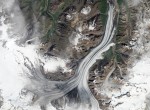Author: Kim Martineau4
-

Photo Essay: Norwegian Rocks
Geologist John Templeton recently spent a year on Norway’s west coast trying to understand how rocks now at the surface made an epic journey deep into Earth’s interior and back during the growth and subsequent collapse of the ancient Caledonian mountains. Check out a photo essay describing his work.
-

Barbados Corals
A new video, “Flip Flops and Outcrops,” captures good vibrations from a recent Columbia University geology field trip to the Caribbean island of Barbados
-

Climate Change Innovator Elected to National Academy
Peter Kelemen, a geologist at Lamont-Doherty Earth Observatory who studies rocks from the deep earth and, recently, their possible uses in battling climate change, has been elected to the National Academy of Sciences.
-

Did New Zealand Dust Influence the Last Ice Age?
Bess Koffman, a postdoctoral researcher at Lamont-Doherty Earth Observatory, recently traveled to New Zealand to collect dust ground-up by glaciers during the last ice age. In this photo essay, she explains how she collected the dust, what analysis looks like in the lab and what she hopes to learn.
-

Has Global Warming Stalled? How Long Will It Last?
Climate Scientist Lisa Goddard talks about what may be behind the recent slowdown in global warming, and some of the nuances of predicting just how the climate will change.
-

Rising Seas Pose a Growing Threat to Coastlines
The jury is still out on how tropical storms will change as climate warms, but rising sea levels will almost certainly place more coastal property at risk of flooding, says a team of scientists writing in the journal Nature.
-

The Dinosaurs’ Demise Up Close
Tourists flock to Italy to see Michelangelo’s David and other iconic hunks of Renaissance stone, but in a trip over spring break, a group of Columbia students got to visit rocks that have shaped the world in even more profound ways.
-

When the Sahara Turned to Sand
The Sahara wasn’t always a desert. Trees and grasslands dominated the landscape from roughly 10,000 to 5,000 years ago. Then, abruptly, the climate changed. A study by Lamont-Doherty’s Peter deMenocal says it took just a few hundred years to happen.

